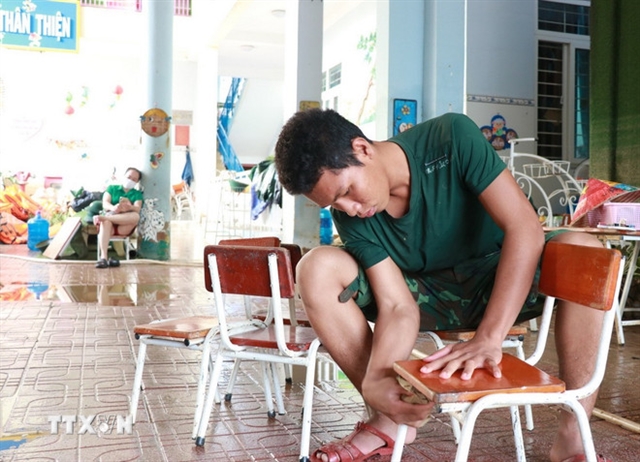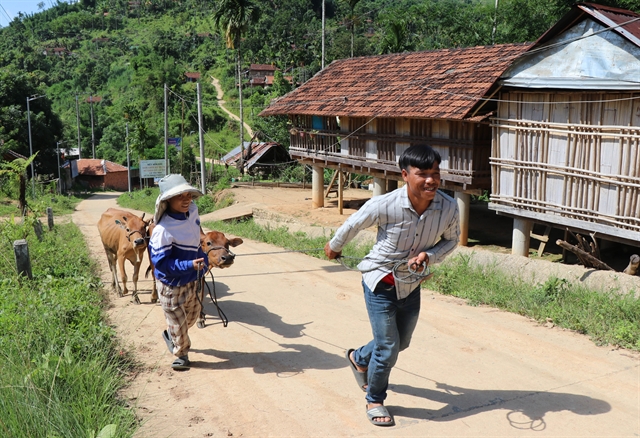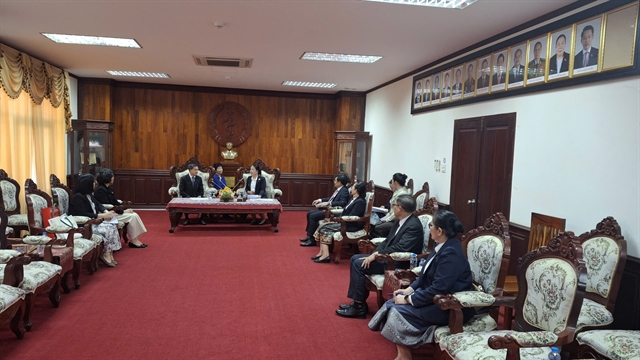 Society
Society

 |
| A pair of cows is given by the National Target Programme for Sustainable Poverty Reduction to a near-poor household in Tang Tong Village, Sơn Liên Commune, the central province of Quảng Ngãi. — VNA/VNS Photo Phạm Cường |
HÀ NỘI — Alongside support policies from the Party and State, education, especially vocational education, is considered one of the systematic and sustainable solutions to poverty.
A national survey released in January 2023 showed that the rate of households living under or near the poverty line in 2022 was 7.52 per cent, numbering over 1.97 million, based on the multidimensional poverty standards for 2022-25.
This year, the country’s poverty rate is estimated to decline to 2.93 per cent, down 1.1 per cent, while the rate of poor households in poor districts is expected to stand at about 33 per cent, a reduction of 5.62 per cent, and the rate in ethnic minority groups is hoped to drop to 17.8 per cent, completing the targets set by the National Assembly and Government.
However, according to the Ministry of Labour, Invalids and Social Affairs (MoLISA), poor people in Việt Nam easily fall back into poverty, especially those in mountainous and ethnic minority-inhabited areas.
A report released by the ministry in the second half of 2022 indicated that poverty reduction in Việt Nam has yet to be sustainable, as the risk of falling back into poverty is high.
It clarified that 20 per cent of households from ethnic minority groups who escaped poverty in 2016 fell back into poverty by 2018, while the rate among Kinh and Hoa groups was 7.6 per cent.
In the 2021-25 period, total capital poured into the National Target Programme on Poverty Reduction is VNĐ28 trillion (US$1.14 billion).
However, efforts towards sustainable poverty reduction have run into many difficulties as the majority of households living under or near the poverty line have difficulty finding sustainable livelihoods, especially those who lack professional skills.
MoLISA Deputy Minister Lê Văn Thanh said that in order to reduce poverty in a sustainable manner, it is necessary to promote the internal strengths of the people and the community, with special focus on developing socio-economic infrastructure, vocational training, creating jobs and improving income for the poor.
MoLISA’s data showed that in the 2016-20 period, 38 per cent of target households escaped poverty and 53 per cent of families became well-off households after receiving short-term vocational training support, while 90 per cent of people, after vocational training at intermediate and college levels, found stable jobs and enjoyed good income, and sustainably escaped poverty.
In the National Target Programme for Sustainable Poverty Reduction in 2021-25, vocational training and job creation have been included into a particular project with specific targets, roadmap and criteria.
The project aims to boost vocational training development in terms of scale and quality, providing vocational training support to the poor and people in poor areas, associating vocational training and job creation and sustainable livelihood development, increasing incomes and improving living conditions for labourers from poor and near-poor households as well as households newly escaped from poverty.
Đào Trọng Độ, head of the Continuing Training Department under MoLISA’s Directorate of Vocational Education and Training (DVET), said that vocational training is an effective approach to sustainable poverty reduction which will solve the shortage in income and access to fundamental social services.
Dr. Nguyễn Thị Thu Dung, Principal of the Thái Bình Medical College and National Assembly deputy, believes that poverty reduction policies need to be redesigned to focus on investing in human resources, particularly emphasising vocational training, which is a crucial "fishing rod".
Dung said the current State-sponsored provision of vocational training for the poor mainly consists of short-term training courses, skills transmission, and providing hands-on assistance in simple, rudimentary occupations and trades. However, this approach has not proven to be truly effective and sustainable due to rapid changes in production technology and the dynamics of the current world.
The very first group that are affected by these changes are the poor as they lack accumulated assets and the skills to adapt to these changes.
Many studies on economic growth and poverty reduction argue that enhancing productive capacity for the poor is the root to ensure sustainable poverty reduction. Therefore, it is necessary to deeply embrace the spirit of "teaching a man to fish rather than giving him fish".
In addition to investing in infrastructure, connecting with developed regions, providing financial support, production techniques and product consumption, it is important to focus on improving the professional and technical skills of the poor, giving them opportunities to find employment and participate in the economic growth process, and directly benefit from it.
The World Bank and the International Labour Organisation (ILO) recommended that Việt Nam should improve labour productivity and skills, which is the key pillar for sustainable poverty reduction and growth. Instead of providing short-term vocational training support, the country should focus on formal vocational training at vocational schools, they advised.
Lessons learned in some countries such as Bangladesh, the Philippines, and the Republic of Korea affirmed the success of linking vocational education with sustainable poverty reduction. For Việt Nam, many research reports also indicated that vocational education has a direct impact on employment and income, affecting the poverty status of households.
Multidimensional poverty in the group of household heads who have graduated from college or university is less than 1 per cent, while the poverty status of the group whose household heads have not completed primary school is up to 26.6 per cent. The poverty rate decreased in households whose heads had higher levels of education, and the pace of poverty reduction in households whose heads worked without vocational skills was lower than in other household groups.
On May 28, 2020, the Prime Minister issued a directive promoting the development of skilled human resources, contributing to improving labour productivity and increasing national competitiveness.
Accordingly, Việt Nam strives to have vocational education approaching the level of ASEAN-4 countries (namely Indonesia, Malaysia, Thailand and the Philippines) by 2030, and by 2045 to be approaching the level of G20 countries. This is an effective way for people to get rid of poverty without falling back again. — VNS




